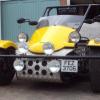Ok, I have written to the DVLA to answer some of the 'what constitutes a modificaiton' question and they have passed it on to our original correspondent, Mark at VOSA. So on behalf of the DVLA here is his response to my questions.
Some questions are similar, and after the first answer you kinda get the jist that the other questions will have the same answer. However there is some interesting information.
My questions in
bold------------------
"Approvals
Testing and Support Services (TaSS)
VOSA,
Ellipse,
Padley Road,
Swansea,
SA1 8AN.
Good afternoon Craig ,
Thank you for your further enquiry regarding this matter which has been
passed to me by the DVLA due to its technical nature. This has caused a
delay in you receiving a reply, for which I apologise. Your questions are
more involved than you might think, but I shall try to answer all the
points raised to enable you and your readers to make an informed decision
on the merits of modifying vehicles. I shall start by explaining the basic
understanding surrounding these matters.
Where a vehicle is notified to the DVLA as being modified (by either an MoT
inspection or owner notification) there are two basic considerations:
Has the vehicle identity been lost (is the original chassis number still
present and legible and/or have so many different parts been used in the
rebuild that the vehicle no longer retains enough original components to
retain its identity ?)
Has the vehicle been modified in such a way that the original Type
Approval granted to the vehicle, is no longer valid. This could include
items such as chassis modifications, braking specification changes and
major engine and transmission modifications (such as Honda VTEC,
Vauxhall 16 valve etc, engine changes)
To this end, the DVLA will inspect vehicles that have been substantially
rebuilt or modified, to decide if they can retain the original registration
number allocated to them. If they decide that the vehicle has been
modified, or substantially altered, from its original specification, but
is not a kit conversion, a points system will be allocated to the major
components to establish if the vehicle can retain its original registration
mark. If the components score less than eight points, or a second hand /
modified chassis or frame (or altered monocoque bodyshell) is used, the
vehicle will require an Individual Vehicle Approval (IVA) test and will not
retain its original identity or registration number. It will also be issued
with a new chassis number which will start with SABTVR.
I have to stress at this point that this is a decision that is taken solely
by the DVLA and VOSA have no part to play in the outcome. Once this
decision is made, it is the responsibility of VOSA to test the vehicle
correctly, according to the applicable legislation. Ultimately, the actual
test the vehicle receives (be it a Basic IVA or a Normal IVA) is completely
reliant upon the circumstances of the individual vehicle history, not the
actual modifications carried out.
My answers amplify the fact that this is
a very subjective area and my interpretation may not accurately be
reflected by the DVLA Inspector.I have answered each of your following questions in sequential order, in
blue text, to aid clarity
On a car like a classic Mini it is almost completely comprised of items
that can be replaced when they wear or need repair. Service items that have been replaced through wear and tear are of no concern in this matter.
Another consideration is that finding original parts from the date of
manufacture is nigh on impossible and so a thriving parts business is
supplying the scene. Again, this is acknowledged and is of no concern.
Please can you confirm the point system is used to decide whether a car
needs an IVA test please.Explained in opening paragraph above.
Assuming the points system is used, could you please list what would
constitute a 'modification' in the eyes of the DVLA to each area? And
perhaps indicate the number of points each question would or would not
achieve under the Registering a radically altered vehicle criteria. This is covered under the DVLA guide known as the INF 26. I have attached a link to
this document for your information.
http://www.dvla.gov....flets/inf26.pdfQUESTIONS:
Would a change from original dampers (shock absorbers) to new replacement
items class as a suspension mod? Again this is a service item and as such
would not be a cause for concern. The fitment of HiLo`s and other
suspension enhancements in isolation would not be an issue, however,
modifications such as full air suspension should be notified to the DVLA,
due to the implications on Type Approval status.
Would replacement of the whole suspension system, for like-for-like newly
manufactured parts, constitute a modification? Not in isolation, but as part of a package of changes, this could be an issue (is the vehicle now
made up of so many new parts that it has lost its original identity ?)
How does using newly manufactured modern parts specifically designed and
approved for the classic Mini, as replacement for service items stand as a
modification? See previous questions.
Basically, if Mini owners replace
old parts for bits bought from companies who are making replacement items,
will the be considered a modification? Again, not in isolation.
What classifies as a body modification? Would the replacement of a panel or
numerous panels, like for like, be considered a modification or a repair? A modification is where the original specification has been altered or
changed in such a way that has an effect on the vehicle specification. A
good example would be shortening the overall length of the vehicle or
removing the roof. Simply repairing body panels would not be an issue.
Would a flip front, or removable front end be considered a modification
where the shape and strength of material is the same or greater than that
at manufacture? This would have to be assessed on a vehicle by vehicle
basis. The underlying issue would be, has the vehicle monocoque been
altered or modified ? In cases where the monocoque remains intact and there
have been no modifications to the attachment points for the engine,
suspension and steering components, then the vehicle should not fail the
DVLA inspection (but
this is subjective, based on the DVLA Inspectors
opinion). In cases where the monocoque has been cut or altered then this
could be problematic.
Would a change in wheel size from, say, 10 inches, to 13 inches, be
considered a modification under the points scheme.Wheel size alone may not be an issue, the actual deciding factor is the rolling circumference and
tyre contact width. Again a pragmatic approach would be taken, but I
suspect a size change of that magnitude would involve other modifications
as well, which could cause further issues.
If the wheelarch aperture was slightly cut to allow the use of larger
wheels, would this be considered a body modification? Again, only if the modification had other consequences as stated above.
Would a custom subframe, (where in the Mini it is separate from the
bodyshell), come under any classification of modification? Only in circumstances where the subframe had not followed the original design in
areas such as steering rack mounting points etc.
Would the installation of an aftermarket sunroof where the body needed to
be cut constitute a body modification under the points scheme? Again a pragmatic approach would be taken. Assuming that the work had been done to
a satisfactory standard and the sunroof was a reasonable size (not a full
roof type) then this would not be an issue. However, full roof types (where
the roof is replaced by a flexible cover that runs in tracking)this would
certainly be a cause for concern.
Does a change of steering wheel constitute a steering assembly
modification? Again, not in isolation.
Would replacing a worn steering rack with a newly manufactured replacement
item constitute a modification? Service items that have been replaced
through wear and tear are of no concern, however, modified items (such as
Escort racks) could be problematic with regard to the frontal impact
requirements of Type Approval.
Would replacing the original suspension struts with adjustable aftermarket
items constitute a modification? The fitment of HiLo`s and other suspension
enhancements in isolation would not be an issue, however, modifications
such as full air suspension should be notified to the DVLA, due to the
implications on Type Approval status.
Do ANY body modifications require an immediate IVA or is it again totted up
on the points system? Again,the underlying issue would be, has the vehicle
monocoque been altered or modified ? If the answer is yes, then IVA is
almost inevitable. If the vehicles identity is lost (shell swap
perhaps)then again IVA would be appropriate.
Would cutting off the bonnet lip (to enable the fitting of a MkI grille)
constitute a body modification (and therefore an IVA?)? Again a pragmatic approach would be taken. Assuming that this is the only modification then
it would not be an issue, however if part of a number of changes then it
could potentially be an issue.
One final question:
From your knowledge of classic Minis, (and assuming a standard Mini was put
the IVA (just roll with me here)), what would you see the classic Mini
failing on in the IVA, i.e what would need to be addressed for it to pass
the IVA?The starting point here is the type of test. Under Normal IVA (NIVA) the
vehicle presenter is required to provide Directive compliance and as such,
would not be able to comply. Under Basic IVA (BIVA) the following issues
would have to be addressed:
The first issue would be the exterior projections on the vehicle. As the
original vehicle did not have to meet the requirements of this test, there
may be items such as the rain gutters etc, that do not meet these
requirements. The exact requirements are listed under Section 16 of the IVA
manual (Projections).
The second issue would be the Mini steering column, which is not fitted
with a collapsible feature, which is covered under section 14 (Protective
steering).
The third issue would be the seat belts, which are covered under section 31
(Seat belts).
The fourth issue could be the braking system (depending upon the type of
brakes fitted) If disc brakes are fitted to the front then the requirements
have been met, but drum brakes could be problematic. The braking sections
09A, and 09B (with particular attention to the requirements of item 21)
cover these items in detail.
The fifth issue would be the lighting requirements. I can see a number of
items that might currently not meet the requirements of the lighting
section.
The sixth issue would be the head restraints fitted to the seats, which are
covered under section 15 (Seat strength).
The seventh issue would be the interior projections inside the vehicle. As
the original vehicle did not have to meet the requirements of this test,
there may be items such as the switchgear etc, that do not meet these
requirements. The exact requirements are listed under Section 12 of the IVA
manual (Interior fittings).
This is by no means an exhaustive list, just the immediate items that fall
to mind. There are other areas that would require some minor modification
to meet the requirements of the regulations.
I do hope this information is helpful, but should you have any further
questions, please do not hesitate to get in touch.
Best regards,
Mark
Mark Vickers Eng Tech MSOE MIRTE
Technical Officer
Approvals
Passenger Cars & Light Goods Vehicles
Vehicle & Operator Services Agency
Department for Transport."
Edited by CMcB, 21 July 2009 - 06:23 PM.
), and then rebuild it with a new engine & subframes etc would this need to go through the IVA even though the shell was already registered? This meaning that i would then need to build the marcos to '09 regs (collapsable steering column etc).


















